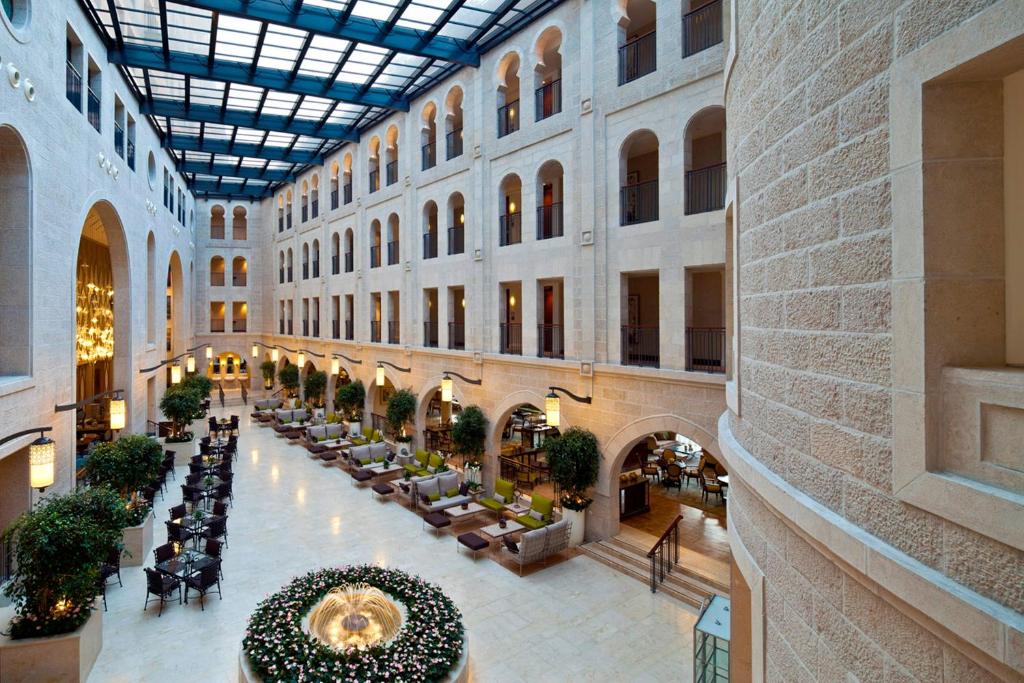It truly is the iconic landmark in one of the world’s most ancient and holy cities. Located at the corner of Agron and King David Streets, the revamped Waldorf Astoria is the pearl of luxury hospitality and provides well-heeled easy access to the upscale Mamilla Mall and the Old City.
Designed by award-winning Turkish architect and interior designer Sinan Kafadar, this oasis of peace and relaxation offers legendary hospitality services, elegant amenities. lavish accommodations, creating unforgettable experiences that will last a lifetime

Israeli architect Yehuda Feigin worked elbow-to-elbow with interior designer Sinan Kafadar to preserve much of the existing design while adding contemporary touches. The outstanding lobby feature in every Waldorf is a replica of the Waldorf Astoria clock first introduced at the 1893 World Fair in Chicago. (Avraham Aborgil designed the Jerusalem Waldorf clock with four faces adorned with Hebrew, Arabic, Roman and European numerals).
A look to the sky reveals one of the hotel’s most remarkable engineering elements where the lobby roof can be completely opened to the heavens in a matter of minutes. This feature, involving several dozen moving glass panels, was specifically intended to allow the lobby to be transformed into one of the world’s most exclusive “sukkah” locations (meaning a hut-like structure bearing a religious symbolism. It commemorates the time Israelitis spent in the wilderness after they fled Egypt.)
The hotel deserves the award for the “most expensive” and “most luxurious” in the country, boasting “the biggest” reception hall in Jerusalem, it has been completed after a decade of construction and an overall investment of $150 million.
The original New York version served as a symbol for the Jerusalem hotel; it forms a triangle, created by the meeting point of four-story “old” wing (meaning, the new adjoined to the old wall) and the nine-story new wing. The lobby contains two restaurants offering different styles of cuisine.
The only remnant of the hotel’s historic grandeur is a wall from the luxurious Palace Hotel, which was only open for five years in the 1930s before it was converted to government offices. Still, the hotel creates an appearance that integrates the fibers of the city’s past – as if that past had been here all along.
Incorporating only the facade of the historic Palace Hotel and an aura of the past, the world-famous Waldorf puts itself on the map of the city’s luxury accommodations. The inner courtyard appears small and almost intimate. Its arching walls of Jerusalem stone look like the petrified branches of an ancient “forest”. The original entryway from the Palace was torn down and rebuilt with laser-like precision.
Aside from the 226 rooms and suites, the hotel also features ball and conference rooms, a banquet hall with eight-meter high ceilings, as well as a lobby area complete with craft-decorated carpets and spectacular glass lamps dangling from the ceiling. The outdoor space enjoys pools, spa facility and a roof garden on the smaller part of the structure. It was planned as “a city within a city,” and any internal communication or gathering is done in the joint lobby.
READ ALSO – Tel Aviv’s striking luxury penthouse by Irma Orenstein
The design approach discarded the essential, smooth, or light, and went for a rich, heavy and sort of “multi-layered” interpretation (the sculptural chandeliers are worth mentioning). For example, an art installation features four dozen glass doves hanging near the stairs that lead down to the lower floors, flying silently above a statue meant to represent Jerusalem’s place at the center of the world.
The special wood floor surface features Foxtrot design by architect Matteo Nunziati for Listone Giordano in a soft shade of white. A grid composed of a rational weave of lines gives life to a wooden fabric that loses the traditional forms of parquet to acquire a whole new elegance.
Geometric shapes that differ substantially from the traditional plank, creating an abacus of square and rectangular elements that can be freely combined to create new and different surfaces.
A charm that runs along the edge of a rational balance obtained by combining elements that are dissimilar to each other. A sort of modern conception of classicism in which the balance between the parts is not given by symmetry, but by different shapes and formats that combined in a single context create a harmony, an aesthetic coherence, an order and a balance where unit can be achieved from multiplicity.
READ ALSO – 432 Park Avenue, Matteo Nunziati interior design flies high
The inspirational environment created by Sinan Kafadar exudes a sense of charming Jerusalem spirit, a unique combination of history and rich modern luxury. Guests can enjoy an exciting mixture of cultures, creating a fascinating space beyond the hotel’s beautifully preserved 90-year old facade. “We take pride in delivering legendary and bespoke True Waldorf Service to all of our guests during their entire stay” explained the architect. Perfectly set in the heart of the city, it’s the ideal destination for cultural visits and religious attractions that only Jerusalem has to offer.
Welcome to the new age of Waldorf Astoria Palace.